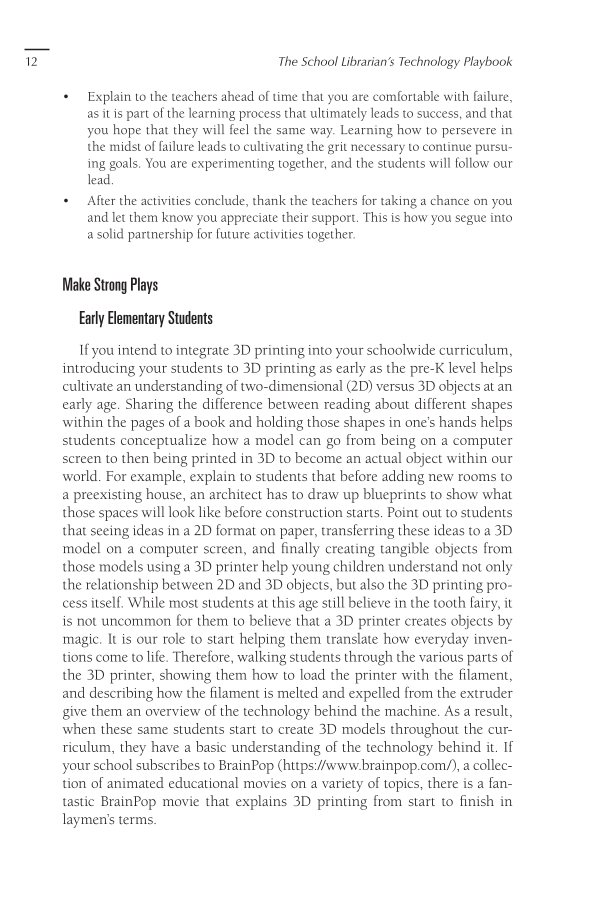12 The School Librarian’s Technology Playbook • Explain to the teachers ahead of time that you are comfortable with failure, as it is part of the learning process that ultimately leads to success, and that you hope that they will feel the same way. Learning how to persevere in the midst of failure leads to cultivating the grit necessary to continue pursu- ing goals. You are experimenting together, and the students will follow our lead. • After the activities conclude, thank the teachers for taking a chance on you and let them know you appreciate their support. This is how you segue into a solid partnership for future activities together. Make Strong Plays Early Elementary Students If you intend to integrate 3D printing into your schoolwide curriculum, introducing your students to 3D printing as early as the pre-K level helps cultivate an understanding of two-dimensional (2D) versus 3D objects at an early age. Sharing the difference between reading about different shapes within the pages of a book and holding those shapes in one’s hands helps students conceptualize how a model can go from being on a computer screen to then being printed in 3D to become an actual object within our world. For example, explain to students that before adding new rooms to a preexisting house, an architect has to draw up blueprints to show what those spaces will look like before construction starts. Point out to students that seeing ideas in a 2D format on paper, transferring these ideas to a 3D model on a computer screen, and finally creating tangible objects from those models using a 3D printer help young children understand not only the relationship between 2D and 3D objects, but also the 3D printing pro cess itself. While most students at this age still believe in the tooth fairy, it is not uncommon for them to believe that a 3D printer creates objects by magic. It is our role to start helping them translate how everyday inven- tions come to life. Therefore, walking students through the various parts of the 3D printer, showing them how to load the printer with the filament, and describing how the filament is melted and expelled from the extruder give them an overview of the technology behind the machine. As a result, when these same students start to create 3D models throughout the cur- riculum, they have a basic understanding of the technology behind it. If your school subscribes to BrainPop (https://www . brainpop . com / ), a collec- tion of animated educational movies on a variety of topics, there is a fan- tastic BrainPop movie that explains 3D printing from start to finish in laymen’s terms.
Document Details My Account Print multiple pages
Print
You have printed 0 times in the last 24 hours.
Your print count will reset on at .
You may print 0 more time(s) before then.
You may print a maximum of 0 pages at a time.

























































































































































































































































